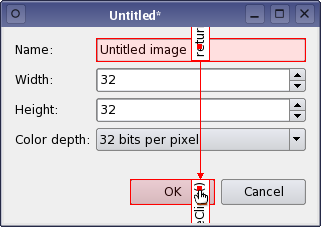- PyQt Tutorial
- Signals And Slots Qt Tutorial Key
- Signals And Slots Qt Tutorial Cheat
- Signals And Slots Qt Tutorial Free
- Signals And Slots Qt Tutorial Gratis
The Qt signals/slots and property system are based on the ability to introspect the objects at runtime. Introspection means being able to list the methods and properties of an object and have all kinds of information about them such as the type of their arguments. QtScript and QML would have hardly been possible without that ability. Important: Please read the Qt Code of Conduct. And it seems to be a multi-thread signal/slot connect issue. 1 Reply Last reply. See full list on evileg.com.
- PyQt Useful Resources
- Selected Reading
Unlike a console mode application, which is executed in a sequential manner, a GUI based application is event driven. Functions or methods are executed in response to user's actions like clicking on a button, selecting an item from a collection or a mouse click etc., called events.
Widgets used to build the GUI interface act as the source of such events. Each PyQt widget, which is derived from QObject class, is designed to emit ‘signal' in response to one or more events. The signal on its own does not perform any action. Instead, it is ‘connected' to a ‘slot'. The slot can be any callable Python function.
In PyQt, connection between a signal and a slot can be achieved in different ways. Following are most commonly used techniques −
A more convenient way to call a slot_function, when a signal is emitted by a widget is as follows −
Suppose if a function is to be called when a button is clicked. Here, the clicked signal is to be connected to a callable function. It can be achieved in any of the following two techniques −
or
Example
In the following example, two QPushButton objects (b1 and b2) are added in QDialog window. We want to call functions b1_clicked() and b2_clicked() on clicking b1 and b2 respectively.
When b1 is clicked, the clicked() signal is connected to b1_clicked() function

When b2 is clicked, the clicked() signal is connected to b2_clicked() function
Example
The above code produces the following output −
Output
This article is the most comprehensive description of signals and slots in QML compared to all previous articles on this site.
In this article, I will try to explain the following when working with Qt/QML + Qt/C++:
- ways to declare signals and slots, also called methods in the C ++ class, which will be registered in the QML layer
- ways to connect to signals of classes declared in C ++ as context
- work with Q_PROPERTY, which also requires signals and slots
- ways to connect signals and slots in QML
- etc.
Signals and slots from the C++ class
Signals And Slots Qt Tutorial Key

Let's create our first class that will work with signals and slots in QML. This is one of the very first examples that I have already shown, but I will repeat this example so that the article is as complete as possible.
In this example, I want to create an application that has one button and by pressing this button increases the counter that is inside the C++ class. This C++ class will be registered as a context property in the QML engine of our application.
App appearance will be next
AppCore.h
Declaring signals and slots in C ++ code will not differ much from the classical Qt/C++.
AppCore.cpp
As well as the implementation of the methods themselves.
main.cpp
main.qml
And now the most interesting. How to use an object loaded in a QML context and how to connect to its signals.
As you remember, we loaded the object into the context QML under the name appCore , we will use this object to access it. But to connect to the signal, we will need to use the QML type Connections .
Thus, you can access the object that was loaded into the context of the QML engine, call its slot, and process the signal from this object.
It is also not necessary to declare receiveFromQml() as a slot in this case. This method can also be declared as Q_INVOKABLE method.
Using Q_PROPERTY
The next option is to use the Q_PROPERTY macro. A classic property in Qt might look like this for our task
This property has the following components:
- type of property, as well as its name: int counter , which are bound to the variable int m_counter inside the class, this is the logic of code generation in Qt
- name of the method to read, matches the name of the property: counter
- method name for setting the value: setCounter
- signal that reports property changes: counterChanged
You can also pass additional parameters to this macro, but this is beyond the scope of this article. And also the property can be read only, that is, without a setter.
Now look at the full code using Q_PROPERTY
AppCore.h
AppCore.cpp
main.qml
Here you will see that connecting the property and accessing it has become easier thanks to the declarative style of QML code. Of course, you cannot always use properties, sometimes you just need to use signals, slots, and Q_INVOKABLE methods. But for variables like counter, properties are likely to be much more convenient.
Connecting signals inside QML files
Now consider the option of connecting signals and slots (functions) inside QML files. There will no longer be any C ++ code.
Among other things, you can use and disable signals from slots
Connect a signal to a signal
Also in QML there is still the ability to connect a signal to a signal, as in Qt/C++. Look at the following artificial example.
Signals And Slots Qt Tutorial Cheat
In this case, the counter will continue to increase when the button is pressed. But the button press signal is not connected directly to the counter increase function, but is forwarded through the signal.
Using Variables in Signals
Signals And Slots Qt Tutorial Free
QML also has the ability to use variables in signals.
Signals And Slots Qt Tutorial Gratis
Conclusion

When b2 is clicked, the clicked() signal is connected to b2_clicked() function
Example
The above code produces the following output −
Output
This article is the most comprehensive description of signals and slots in QML compared to all previous articles on this site.
In this article, I will try to explain the following when working with Qt/QML + Qt/C++:
- ways to declare signals and slots, also called methods in the C ++ class, which will be registered in the QML layer
- ways to connect to signals of classes declared in C ++ as context
- work with Q_PROPERTY, which also requires signals and slots
- ways to connect signals and slots in QML
- etc.
Signals and slots from the C++ class
Signals And Slots Qt Tutorial Key
Let's create our first class that will work with signals and slots in QML. This is one of the very first examples that I have already shown, but I will repeat this example so that the article is as complete as possible.
In this example, I want to create an application that has one button and by pressing this button increases the counter that is inside the C++ class. This C++ class will be registered as a context property in the QML engine of our application.
App appearance will be next
AppCore.h
Declaring signals and slots in C ++ code will not differ much from the classical Qt/C++.
AppCore.cpp
As well as the implementation of the methods themselves.
main.cpp
main.qml
And now the most interesting. How to use an object loaded in a QML context and how to connect to its signals.
As you remember, we loaded the object into the context QML under the name appCore , we will use this object to access it. But to connect to the signal, we will need to use the QML type Connections .
Thus, you can access the object that was loaded into the context of the QML engine, call its slot, and process the signal from this object.
It is also not necessary to declare receiveFromQml() as a slot in this case. This method can also be declared as Q_INVOKABLE method.
Using Q_PROPERTY
The next option is to use the Q_PROPERTY macro. A classic property in Qt might look like this for our task
This property has the following components:
- type of property, as well as its name: int counter , which are bound to the variable int m_counter inside the class, this is the logic of code generation in Qt
- name of the method to read, matches the name of the property: counter
- method name for setting the value: setCounter
- signal that reports property changes: counterChanged
You can also pass additional parameters to this macro, but this is beyond the scope of this article. And also the property can be read only, that is, without a setter.
Now look at the full code using Q_PROPERTY
AppCore.h
AppCore.cpp
main.qml
Here you will see that connecting the property and accessing it has become easier thanks to the declarative style of QML code. Of course, you cannot always use properties, sometimes you just need to use signals, slots, and Q_INVOKABLE methods. But for variables like counter, properties are likely to be much more convenient.
Connecting signals inside QML files
Now consider the option of connecting signals and slots (functions) inside QML files. There will no longer be any C ++ code.
Among other things, you can use and disable signals from slots
Connect a signal to a signal
Also in QML there is still the ability to connect a signal to a signal, as in Qt/C++. Look at the following artificial example.
Signals And Slots Qt Tutorial Cheat
In this case, the counter will continue to increase when the button is pressed. But the button press signal is not connected directly to the counter increase function, but is forwarded through the signal.
Using Variables in Signals
Signals And Slots Qt Tutorial Free
QML also has the ability to use variables in signals.
Signals And Slots Qt Tutorial Gratis
Conclusion
For the most part, this entire article fits into several points:
- In C ++, to interact with the QML layer, you can use signals, slots, Q_INVOKABLE methods, as well as create properties using the Q_PROPERTY macro
- In order to respond to signals from objects, you can use the QML type Connections
- Q_PROPERTY obeys the declarative style of QML and, when a property is changed, it can automatically set new values, if the property has been added to any object in QML. In this case, the signal slot connections are set automatically.
- In QML, you can connect and disconnect signal / slot connections using the following syntax:
- object1.signal.connect (object2.slot)
- object1.signal.disconnect (object2.slot)
- Signals in QML can also be connected to other signals, as is done in Qt / C ++
- Signals in QML may also have arguments

